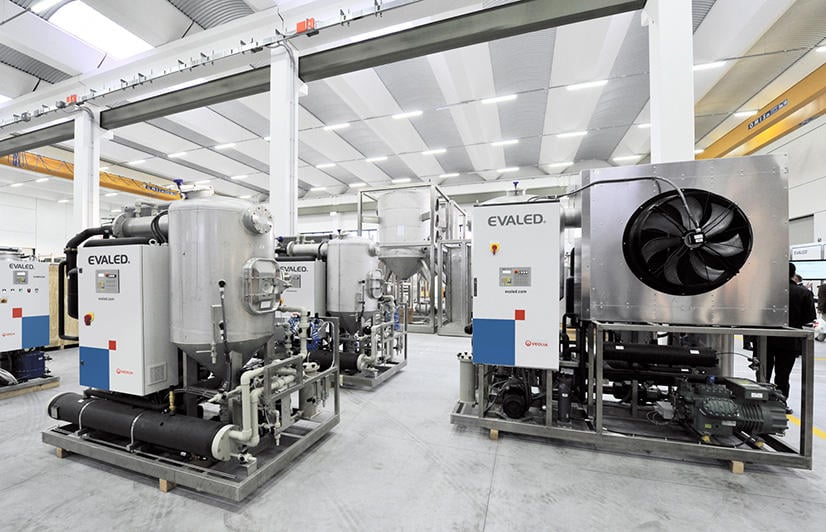Evaporation is a very old technology – think extracting salt from seawater – and has historically been considered uneconomical for wastewater treatment. However, recent advances in evaporation technology, coupled with rising sewer discharge and landfill fees, are making this time-tested method an increasingly viable solution.
Significant Benefits for Modern Industry
Modern evaporation technology offers a sustainable and environmentally conscious approach to waste management, capable of reducing waste volume by up to 90 percent. For facilities managing liquid waste, evaporation provides multiple advantages:
• Substantial reduction in off-site disposal costs
• Recovery of valuable raw materials (including APIs, disinfectants, proteins, and glycols)
• Production of high-quality distilled water for reuse
• Improved environmental compliance
The Process and Technology
The evaporation process concentrates waste into approximately 10 percent of its original volume. While traditional evaporation requires water to reach its boiling point (100°C) - potentially damaging heat sensitive materials - modern solutions offer better alternatives. Today's heat pump evaporators operate under vacuum, allowing water to boil at just 30-40°C, protecting valuable compounds and enabling more efficient processing.
Energy Efficiency and Sustainability
While evaporation systems do require significant power input (typically ~0.15 kWh per litre of distillate), modern designs maximise efficiency through heat recovery systems. A compressor-driven refrigerant circuit captures latent heat from condensing water vapor and reuses it to drive further evaporation. Contemporary systems also incorporate sustainable features like:
• Smart controls for optimised energy usage
• Integration with renewable energy sources
• Low-GWP (Global Warming Potential) refrigerants
• Reduced carbon footprint through local processing
When combined with rising disposal costs and the value of recovered materials, the overall environmental and economic benefits make evaporation increasingly attractive.
Two Key Technological Approaches
Forced Circulation:
This method excels in producing high-quality distillate. The process pumps liquid through a heat exchanger, raising temperatures to about 40°C before entering the evaporator body. Under vacuum, the liquid 'flashes' to vapor, creating a clean separation between liquid and vapor phases through gravity.
Scraped Surface Technology:
Ideal for challenging materials, this approach handles viscous or foaming liquids effectively. Similar to reducing a sauce in cooking, it uses a rotating blade to continuously scrape the heat transfer surface, preventing material from sticking and overheating - crucial for processing difficult waste streams.
Evaled™ Vacuum Evaporators: Advanced Industrial Solutions

Modern industrial evaporation is exemplified by Evaled™ vacuum evaporators, which represent the latest in treatment technology. These systems can process between 1 and 250 tonnes of wastewater per day, offering:
- Fully automated operation and cleaning systems
- Minimal operator intervention required
- Advanced computer-based control systems
- Significantly reduced energy consumption and CO2 footprint
- Compact design requiring minimal floor space
Versatile Applications Across Industries
Evaled™ systems are particularly valuable in:
- Healthcare, pharmaceutical, and cosmetics manufacturing
- Chemical production processes
- Automotive and aviation manufacturing
- Food and beverage processing
- Oil and gas operations
- Power generation facilities
- Mining operations
These evaporators excel in handling challenging waste streams, including hazardous materials and difficult-to-treat wastewaters. Their ability to achieve high concentration ratios while maintaining good separation levels makes them ideal for both waste reduction and product concentration applications.
Evaporation technology has evolved into a sophisticated solution for industrial water treatment. Whether using forced circulation or scraped surface systems, the technology offers significant waste reduction while recovering valuable materials and water. With advancing technology making systems more accessible, efficient, and environmentally friendly, evaporation presents a viable option for facilities of all sizes looking to improve their waste management practices. With solutions like Evaled™ vacuum evaporators, modern evaporation technology offers increasingly efficient and sustainable options for industrial water treatment, combining environmental responsibility with economic viability.
If you think our Evaporation systems could be a good fit for you, please contact one of our experts here.